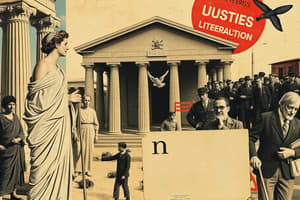Podcast
Questions and Answers
What is a classical oration?
What is a classical oration?
- A religious ceremony
- A five-part argument structure used by classical rhetoricians (correct)
- A form of entertainment
- A type of poem
What is the purpose of the introduction (exordium) in a classical argument?
What is the purpose of the introduction (exordium) in a classical argument?
It introduces the reader to the subject under discussion.
What does narration (narratio) provide?
What does narration (narratio) provide?
Factual information and background material on the subject.
What is included in the confirmation (confirmatio) part of a classical argument?
What is included in the confirmation (confirmatio) part of a classical argument?
What does refutation (refutatio) address?
What does refutation (refutatio) address?
What is the role of the conclusion (peroratio) in a classical argument?
What is the role of the conclusion (peroratio) in a classical argument?
Flashcards are hidden until you start studying
Study Notes
Parts of a Classical Argument
- Classical oration consists of a five-part structure developed by classical rhetoricians for effective argumentation.
Introduction (Exordium)
- Serves to engage the reader and presents the topic that will be discussed, setting the stage for the argument.
Narration (Narratio)
- Provides essential background information and lays out the context of the argument, explaining why the topic requires attention and action.
Confirmation (Confirmatio)
- This section is typically the longest part of the argument, where the main evidential support and proof for the writer's stance are presented.
Refutation (Refutatio)
- Addresses opposing viewpoints or counterarguments, serving as a crucial transition between the main proof and the concluding remarks.
Conclusion (Peroratio)
- Wraps up the essay, summarizing main points and leaving the reader with a sense of closure and finality regarding the argument presented.
Studying That Suits You
Use AI to generate personalized quizzes and flashcards to suit your learning preferences.




